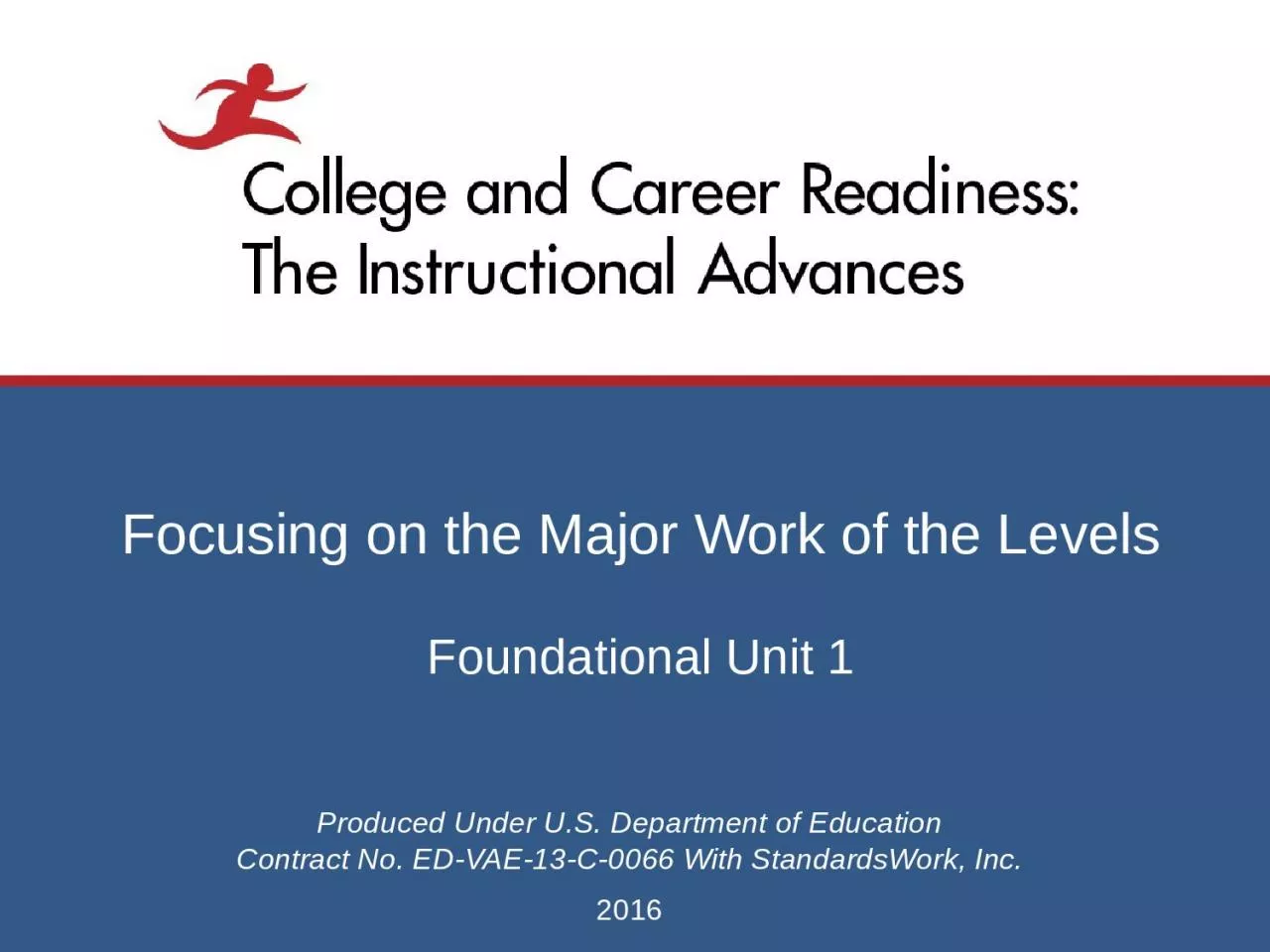

Levels Foundational Unit 1 Produced Under US Department of Education Contract No EDVAE13C 0066 With StandardsWork Inc 2016 Three Key Advances Prompted by the CCR Standards ID: 998620
Download Presentation The PPT/PDF document "Focusing on the Major Work of the" is the property of its rightful owner. Permission is granted to download and print the materials on this web site for personal, non-commercial use only, and to display it on your personal computer provided you do not modify the materials and that you retain all copyright notices contained in the materials. By downloading content from our website, you accept the terms of this agreement.
1. Focusing on the Major Work of the LevelsFoundational Unit 1Produced Under U.S. Department of EducationContract No. ED-VAE-13-C-0066 With StandardsWork, Inc.2016
2. Three Key Advances Prompted by the CCR StandardsFocus: Focus strongly where the CCR Standards focus.Coherence: Design learning around coherent progressions from level to level.Rigor: Pursue conceptual understanding, procedural skill and fluency, and application—all with equal intensity.
3. Unit 1 ObjectivesFocusing on the Major Work of the Levels Understand the research base that explains the importance of focusing each level of the CCR Standards on concepts and skills that are critical for preparing students for college and careers.Delve into the CCR Standards and build an understanding of the critical areas for each level as a foundation for developing a coherent and rigorous mathematics curriculum.
4. Rationale for FocusRelevance and Importance Based on the ResearchHigh-performing nations significantly narrow the scope of content so that students can focus their time and energy. Focusing on too many topics has a negative impact on student performance (TIMSS research). Focusing on what is emphasized in the standards gives students a strong foundation and uses instructional time productively (ACT survey of college faculty).Identifying concepts that support the major work of each level creates a coherent flow of knowledge and skills within the level.
5. Implications of Focus on InstructionFocus means that some content is more important than other content and receives more time and attention.Other content supports the more important content.The Standards for Mathematical Practice become a critical focus in the CCR Standards and the mathematics curriculum.
6. Major Areas of FocusLevel A: Whole numbers—addition and subtraction concepts, skills, and problem-solving to 20; place value and whole number relationships to 100; and reasoning about geometric shapes and linear measuresLevel B: Whole numbers and fractions—place value, comparison, and addition and subtraction to 1000; fluency to 100; multiplication and division to 100; fractions concepts, skills, and problem-solving; 2-dimensional shape concepts; standard units for measuring time, liquid, and mass; and area measurements
7. Major Areas of FocusLevel C: Positive whole numbers, fractions, and decimals—fluency with multi-digit whole number and decimal operations; decimal place value concepts and skills to thousandths; comparing, ordering, and operating with fractions; fluency with sums and differences of fractions; understanding rates and ratios; early expressions and equations; area, surface area, and volume; classification of 2-dimensional shapes; and developing understanding of data distributions, including creating dot plots in the coordinate plane
8. Major Areas of FocusLevel D: Rational numbers—fluent arithmetic of positive and negative rational numbers; applying rates, ratios, and proportions; applying linear expressions, equations, and functions; systems of linear equations; classification and analysis of 2- and 3-dimensional figures; developing similarity and congruence concepts, including problems of scale; solving right triangles using the Pythagorean theorem; random sampling of populations to summarize, describe, display, interpret, and draw inferences; bivariate data and a line of good fit; and development of probability concepts
9. Major Areas of FocusLevel E: Real numbers—extending number system to include all real numbers; equivalent expressions involving radicals and rational exponents; reasoning about units and levels of precision; linear, quadratic, and exponential expressions, equations, and functions; linear inequalities; algebraic and graphic models of functions; applying similarity and congruence to 2-dimensional figures; and analyzing 1- and 2-variable data sets, including using frequency tables
10. Hands-On PracticeNow, let’s do some work on the major work of the levels. . .
11. MaterialsDirections for ParticipantsWorksheet: Focusing on the Major Work of the LevelsResource: Major Work of the LevelsResource: CCR Standards for Adult Education
12. DirectionsCircle the topics on the worksheet for each level that are part of the major focus for that level. Use the Major Work of the Levels resource to help you make your decisions. You also may use a copy of the CCR Standards, if needed.Discuss your selections and rationales at your table. On the following slide, there are some questions to guide your discussion.
13. Discussion QuestionsWhat are some rationales for why you did or did not circle a particular topic as critical to the level? Did anyone have a hard time deciding to which critical area a topic belongs? Tell us where and why.Are any of the lesson objectives that you did not select for the given level critical to a different level? Do you think that any of the topics you did not select are important to teach? If so, how might you relate them to one of the critical areas for the level? Work Session50 minutes
14. ReflectionsWhy focus? There’s so much mathematics that students could be learning, why limit what students are taught?20 minutes
15. Next StepsHow has participating in this activity changed your thinking about the CCR Standards?How will you use the information and understanding you have acquired to improve your teaching practice and student learning?What additional training and tools would strengthen your ability to do so?